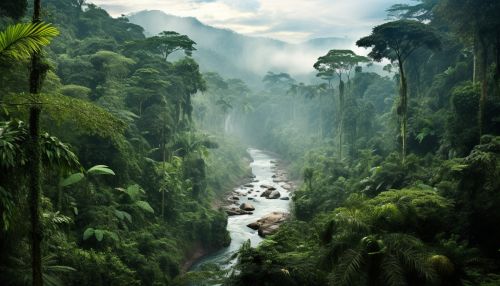Geography of South America
Physical Geography
South America, the fourth largest continent in the world, is characterized by its diverse geographical features ranging from the towering Andes to the vast Amazon basin. The continent is located primarily in the southern hemisphere, with a small portion in the northern hemisphere. It is bordered by the Pacific to the west and the Atlantic to the east.


Mountains
The Andes, the world's longest continental mountain range, stretches along the western edge of South America. The range spans seven countries and includes many of the highest peaks in the Western Hemisphere. The Aconcagua, located in Argentina, is the highest peak in the Andes and the highest outside of Asia.
Plains
The Pampas are a grassland biome located in Argentina, Uruguay, and Brazil. Known for their fertile soil, the Pampas are a major agricultural region, producing a significant portion of the world's soybean and beef. The Llanos of Colombia and Venezuela are another significant plains region, characterized by seasonal flooding and a rich diversity of wildlife.
Rainforests
The Amazon Rainforest, the largest rainforest in the world, covers a vast area of the continent. This biodiverse region is home to millions of species of plants and animals, many of which are not found anywhere else on Earth. The Amazon, the second longest river in the world, flows through the heart of this rainforest.
Deserts
The Atacama, one of the driest places on Earth, is located on the western coast of South America. Despite its harsh conditions, the Atacama is home to a variety of plant and animal species that have adapted to the desert's extreme environment.
Climate
South America's climate varies greatly due to its size and geographic diversity. The continent experiences a range of climate zones from the tropical rainforests of the Amazon to the cold, windy plains of Patagonia. The Andes also create a significant climatic divide, with the western coast experiencing cool, humid conditions due to the cold Humboldt Current, while the eastern plains are warm and dry.
Human Geography
South America is home to a rich tapestry of cultures, languages, and peoples. The continent was first inhabited by indigenous peoples thousands of years ago, and today, it is home to a diverse population of European, African, and indigenous descent.
Countries and Territories
South America is composed of 12 independent countries: Argentina, Bolivia, Brazil, Chile, Colombia, Ecuador, Guyana, Paraguay, Peru, Suriname, Uruguay, and Venezuela. In addition, the continent includes the overseas territories of French Guiana (France), the Falkland Islands (UK), and South Georgia and the South Sandwich Islands (UK).
Languages
The most widely spoken languages in South America are Spanish and Portuguese, due to the historical influence of Spain and Portugal. However, many indigenous languages are also spoken, including Quechua, Aymara, and Guarani.
Cities
South America is home to many vibrant and bustling cities. São Paulo, Brazil, is the largest city in South America, followed by Lima, Peru, and Bogotá, Colombia. Other notable cities include Buenos Aires, Argentina, and Santiago, Chile.
Economy
South America's economy is diverse, with key sectors including agriculture, mining, manufacturing, and services. The continent is rich in natural resources, including petroleum, gold, copper, and iron ore. Brazil has the largest economy in South America, followed by Argentina and Colombia.
Biodiversity
South America is one of the most biodiverse continents on Earth, home to many unique ecosystems and species. The Amazon Rainforest alone is estimated to contain 10% of the world's known biodiversity.


